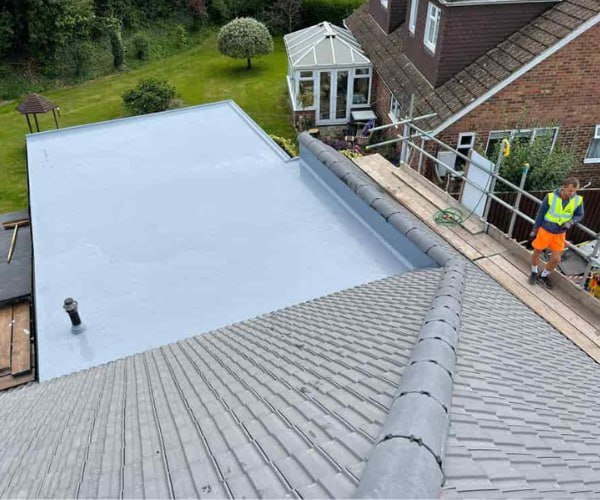Waiting for a Dry Day to Fix a Leak? Don’t.
When it comes to roof leaks, many homeowners make the mistake of waiting for a dry day before taking action. Unfortunately, that delay can often make things worse. Even small leaks can quickly turn into major issues if left unattended, leading to costly internal damage and long-term deterioration.
At CGT Roofing Newport Pagnell, we’ve seen how fast a seemingly minor problem can escalate during wet weather. Taking early action – even when it’s raining – is always the smarter choice. Here’s why postponing repairs can do more harm than good and what you can do to protect your home.
Why You Should Never Wait to Fix a Roof Leak
A leaking roof doesn’t pause for the weather to clear. Moisture continues to find its way through weak points, often spreading silently beneath tiles or roofing felt. By the time the rain stops, the damage may already be far worse than it first appeared.
Key Reasons to Act Immediately
- Leaks worsen quickly: Water can seep into insulation, ceiling joists, and electrical wiring.
- Moisture spreads unseen: Internal dampness often develops before visible stains appear.
- Structural damage begins early: Timber and plasterboard absorb water easily, weakening their integrity.
- Mould can form rapidly: Within 24–48 hours, trapped moisture can lead to mould and mildew growth.
A professional roofing service such as CGT Roofing Newport Pagnell can provide emergency attention even during wet conditions, preventing the situation from escalating further.
How Rain Makes Roof Leaks More Dangerous
Rainwater doesn’t just highlight existing weaknesses – it exploits them. Once water finds a path through worn tiles, cracked flashing, or damaged felt, it can travel extensively within the roof structure.
Common Issues Exacerbated by Rain
- Loose or slipped tiles: Rainwater seeps into the exposed underlay.
- Worn lead flashing: Moisture enters at joints around chimneys or skylights.
- Blocked gutters or valleys: Overflowing water seeps under roofing materials.
- Perished sealant or mortar: Allows water ingress around ridges and edges.
Rain often reveals problems that were already developing. Delaying inspection or repair allows those problems to compound, particularly during consecutive wet days.
Temporary Measures vs Professional Repairs
While it might seem reasonable to apply a quick patch or sealant to stop a leak temporarily, these short-term fixes rarely address the underlying cause.
The Limitations of Temporary Fixes
- Quick repairs often trap moisture inside the roof layers.
- Makeshift patches can deteriorate rapidly under UV exposure.
- Improper sealing may divert water rather than stop it.
Instead, it’s better to have an expert roofer inspect and diagnose the issue properly. At CGT Roofing Newport Pagnell, we use safe, professional methods to stabilise roofs in wet conditions before carrying out a thorough repair once the weather improves.
Why Wet-Weather Roof Repairs Are Possible
Modern roofing materials and safety methods allow professional roofers to address leaks even during rain. While complete re-roofing work may require dry conditions, emergency leak control and temporary waterproofing can be completed safely and effectively.
Common Wet-Weather Solutions
- Applying temporary waterproof membranes or tarpaulins to stop ingress.
- Using specialist sealants designed for damp surfaces.
- Clearing debris and blocked drainage to restore proper water flow.
- Assessing underlayment damage and identifying weak spots for follow-up repairs.
This approach limits further deterioration and buys time for more comprehensive restoration once the conditions are ideal.
Long-Term Impact of Ignoring Roof Leaks
Every delay in dealing with a leak allows water to infiltrate deeper into the building’s structure. Over time, this can compromise insulation efficiency, encourage wood rot, and even impact the stability of the roof frame.
Potential Consequences of Inaction
- Ceiling staining and plaster cracking.
- Rotting timbers or weakened trusses.
- Persistent damp smells and mould growth.
- Degraded insulation and higher energy costs.
A roof leak isn’t just an inconvenience – it’s an early warning sign of potential structural decay. Prompt intervention protects both the property’s integrity and its value.
Preventing Future Leaks
While it’s vital to repair leaks promptly, prevention is equally important. Regular roof inspections can help detect early signs of wear, giving homeowners the chance to address issues before they escalate.
Preventative Steps to Take
- Schedule annual roof inspections with a professional.
- Keep gutters and downpipes clear of leaves and debris.
- Replace cracked tiles or damaged flashing immediately.
- Check loft spaces regularly for damp spots or musty smells.
At CGT Roofing Newport Pagnell, our expert team provides maintenance advice and practical solutions to keep roofs in excellent condition year-round.
Conclusion
Waiting for a dry day to fix a roof leak can turn a small problem into a major headache. The longer water is allowed to penetrate your roof, the greater the damage it causes. Acting swiftly, even during bad weather, is the best way to protect your home and avoid long-term structural issues.
CGT Roofing Newport Pagnell in Newport Pagnell, Buckinghamshire, offers professional roof inspections and emergency leak repairs designed to safeguard your property, whatever the weather. Addressing roof leaks immediately ensures your home remains secure, dry, and protected for the future.
Call us on: 01908 030 895
Click here to find out more about CGT Roofing Newport Pagnell
Click here to complete our contact form and see how we can help with your roofing needs.

